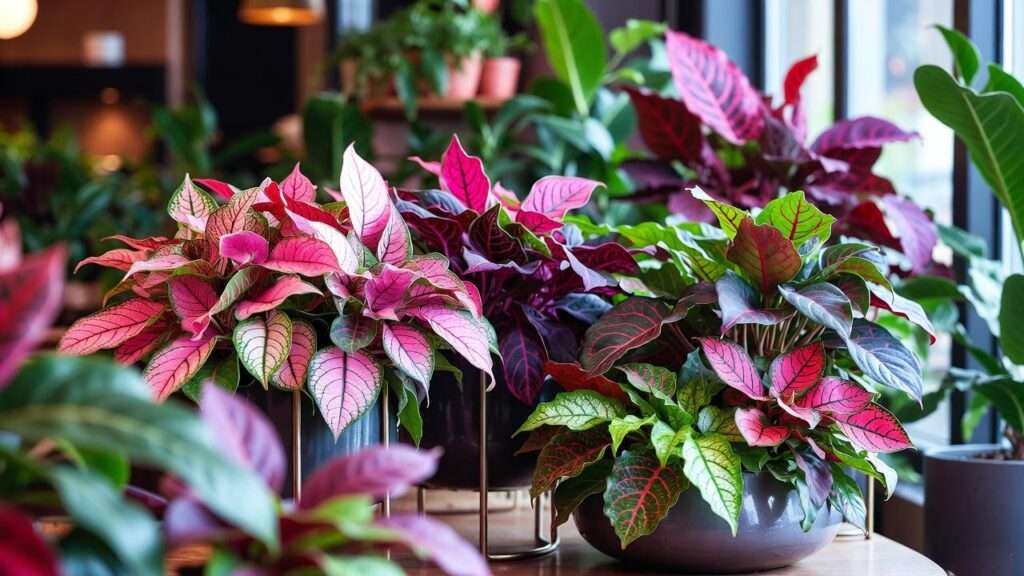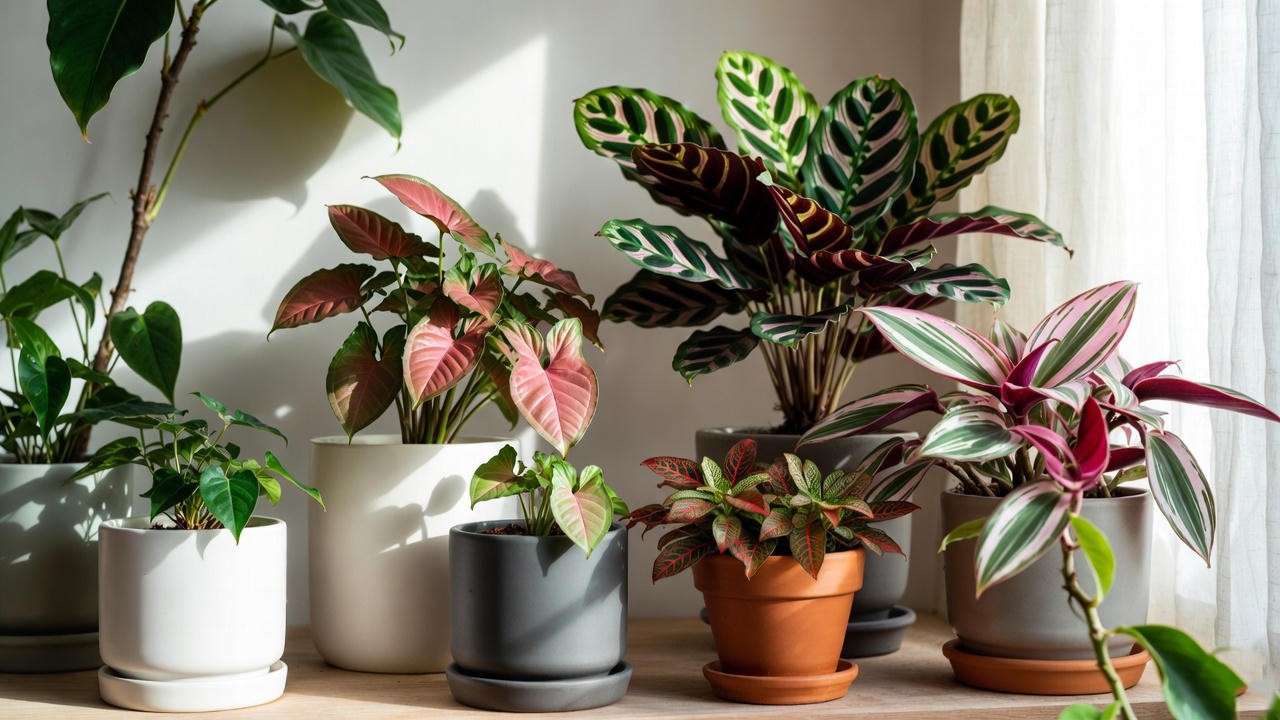Picture this: you step into your living room, and a burst of pink, purple, and red foliage instantly catches your eye, transforming your space into a vibrant oasis. Coloured indoor plants are more than just decor—they’re a bold statement of style and a reflection of your plant care expertise. These stunning plants bring life, personality, and even health benefits to your home. Did you know a 2023 study found that indoor plants can reduce stress by 37%? Whether you’re a seasoned plant parent or a curious beginner, this guide will inspire you with the best coloured indoor plants, expert care tips, and creative styling ideas to elevate your space. Let’s dive into creating your dream indoor jungle! 🌈
1. Why Choose Coloured Indoor Plants? 🌟
The Appeal of Vibrant Foliage in Your Home
Coloured indoor plants are the secret weapon of interior design enthusiasts. Unlike their green counterparts, these plants boast striking hues—think blushing pinks, deep purples, and fiery reds—that instantly elevate any room. They’re perfect for modern aesthetics like boho, minimalist, or maximalist decor. For example, a Pink Syngonium with its heart-shaped, pastel leaves can add a soft pop of colour to a neutral living room, creating a cozy yet chic vibe. These plants don’t just decorate; they define your space with personality and flair.
Psychological and Health Benefits
Beyond aesthetics, coloured indoor plants offer tangible benefits for your well-being. Research, including NASA’s Clean Air Study, shows that plants improve air quality by removing toxins like benzene and formaldehyde. Vibrant foliage also boosts mood and creativity. A 2021 study from the University of Reading found that exposure to colourful plants increased focus and reduced anxiety in 68% of participants. As horticulturist Dr. Emma Green notes, “The vivid hues of plants like Calathea Rattlesnake stimulate positive emotions, making them ideal for home offices or relaxation spaces.”
Unique Appeal Compared to Green Plants
While classic green plants like pothos or monstera are timeless, coloured indoor plants stand out for their bold, eye-catching patterns. Their variegated leaves—splashed with pink, purple, or white—create focal points in any room. They’re especially ideal for small apartments or low-light corners where a splash of colour can make a big impact. Tip: Place a Tradescantia Nanouk on a bookshelf to draw the eye and add vibrancy without overwhelming your space.
2. Top 10 Coloured Indoor Plants to Brighten Your Space 🌸
1. Pink Syngonium (Arrowhead Plant)
With its heart-shaped leaves in shades of pink and cream, the Pink Syngonium is a beginner’s dream. This plant thrives in bright, indirect light and prefers soil that’s kept slightly moist. Water when the top inch feels dry to avoid soggy roots. Its trailing vines make it perfect for hanging baskets, where its delicate pink foliage cascades beautifully. Design Idea: Pair it with a macramé hanger for a boho-chic look.
2. Calathea Rattlesnake
The Calathea Rattlesnake is a showstopper with its wavy, green-and-purple leaves and pinkish undersides. This intermediate-level plant loves high humidity and filtered light, making it ideal for bathrooms or kitchens. Avoid overwatering by checking the soil’s moisture level. Expert Tip: Mist the leaves weekly or place the pot on a pebble tray to mimic its tropical origins, as advised by plant care specialist Sarah Bloom.
3. Fittonia (Nerve Plant)
Known as the Nerve Plant, Fittonia boasts vibrant veins in red, pink, or white against dark green leaves. It’s beginner-friendly and thrives in terrariums due to its love for humidity. Keep the soil consistently moist but not waterlogged, and place it in indirect light. Its compact size makes it perfect for desks or small shelves.
4. Purple Passion Plant (Gynura Aurantiaca)
The Purple Passion Plant lives up to its name with velvety, purple leaves that shimmer in bright light. This intermediate-level plant needs regular pinching to prevent legginess. Place it in a sunny spot to maintain its rich colour, and water sparingly to avoid root rot. Its bold hue pairs well with gold or brass planters for a luxurious look.
5. Stromanthe Triostar
The Stromanthe Triostar is a stunning choice for advanced plant parents, with its cream, pink, and green variegated leaves. It demands high humidity and indirect light to thrive. Avoid direct sun, which can scorch its delicate foliage. Care Tip: Use a humidifier to maintain 50–60% humidity, especially in winter.
6. Tradescantia Nanouk
The Tradescantia Nanouk is a beginner’s delight, featuring soft pink, purple, and green striped leaves. It loves bright light to keep its colours vibrant and prefers well-draining soil. Water when the topsoil feels dry, and propagate cuttings in water for easy sharing. This plant’s compact growth makes it ideal for windowsills.
7. Aglaonema (Chinese Evergreen)
Aglaonema varieties, like the red or pink ‘Siam Aurora,’ are low-maintenance and tolerate low light, making them perfect for beginners. Water sparingly, allowing the soil to dry out between waterings. Its bold foliage adds drama to any room, especially when paired with a sleek, modern pot.
8. Peperomia Rosso
The Peperomia Rosso combines deep green tops with striking red undersides, offering a subtle yet vibrant look. This beginner-friendly plant is drought-tolerant and thrives in indirect light. Its small size makes it a great addition to mixed plant arrangements or tiny apartments.
9. Coleus
Coleus plants are known for their bold patterns in red, yellow, pink, and green. They require bright light to maintain their vivid colours and benefit from regular pruning to stay bushy. This intermediate-level plant is perfect for adding a burst of colour to sunny corners.
10. Oxalis (False Shamrock)
The Oxalis, or False Shamrock, features delicate, triangular leaves in rich purple or burgundy. It’s beginner-friendly, thriving in bright light with occasional watering. Allow the soil to dry out between waterings to prevent bulb rot. Its unique shape makes it a conversation starter in any room.
| Plant | Light | Water | Care Level |
| Pink Syngonium | Bright, indirect | Water when top inch is dry | Beginner |
| Calathea Rattlesnake | Filtered light | Keep soil moist, high humidity | Intermediate |
| Fittonia | Indirect light | Consistently moist | Beginner |
| Purple Passion Plant | Bright light | Water sparingly | Intermediate |
| Stromanthe Triostar | Indirect light | High humidity, moderate water | Advanced |
| Tradescantia Nanouk | Bright light | Water when topsoil is dry | Beginner |
| Aglaonema | Low to bright light | Water sparingly | Beginner |
| Peperomia Rosso | Indirect light | Drought-tolerant | Beginner |
| Coleus | Bright light | Regular watering, prune | Intermediate |
| Oxalis | Bright light | Allow soil to dry | Beginner |
3. How to Care for Coloured Indoor Plants: Expert Tips 🌿
Light Requirements for Coloured Plants
Light is the key to vibrant foliage. Most coloured indoor plants, like Tradescantia Nanouk or Coleus, need bright, indirect light to maintain their stunning hues. Insufficient light can cause variegation to fade, leaving leaves dull or green. For example, a Pink Syngonium placed in a dark corner may lose its pink tones. Tip: If your home lacks natural light, invest in a full-spectrum LED grow light (e.g., Sansi 15W Grow Light, available at trusted retailers). Rotate plants every few weeks to ensure even light exposure.
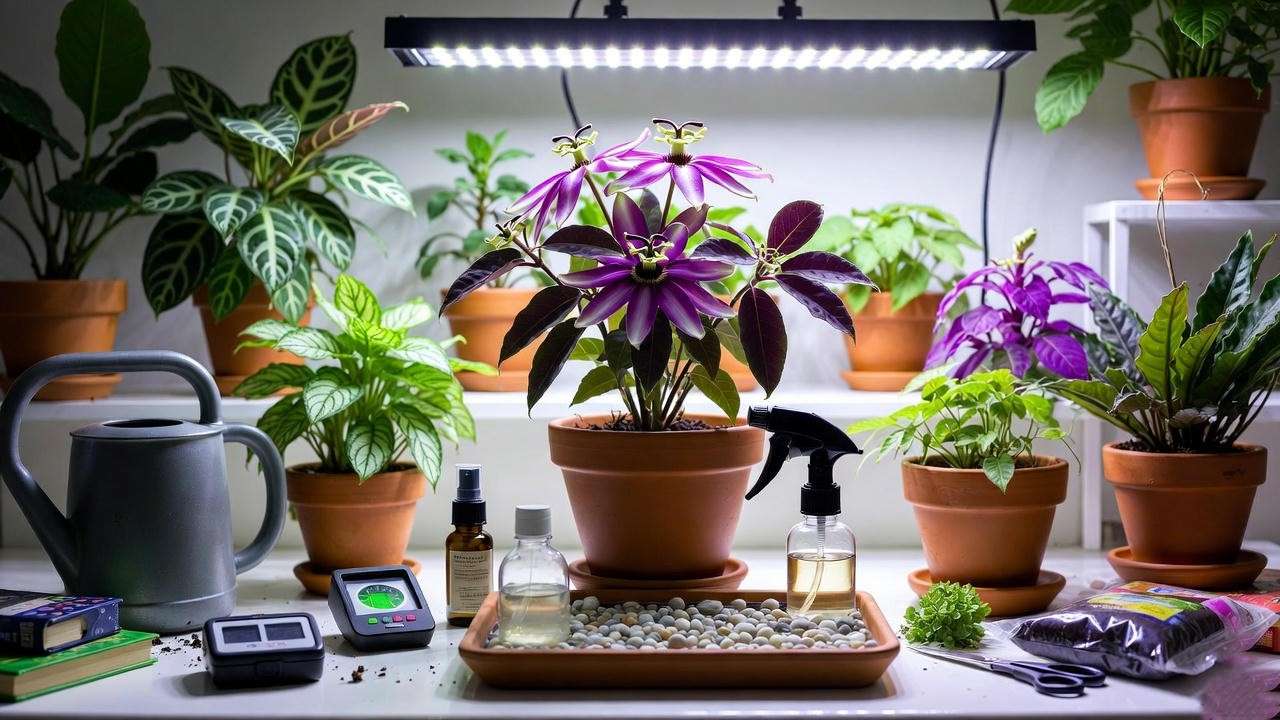
Watering and Humidity Needs
Each coloured plant has unique watering needs. Fittonia thrives on consistently moist soil, while Aglaonema prefers drier conditions. Overwatering is a common mistake, leading to root rot and faded colours. “Check the soil before watering,” advises plant care expert Lisa Carter. “Stick your finger an inch into the soil—if it’s dry, water; if it’s wet, wait.” For humidity-loving plants like Calathea or Stromanthe, maintain 50–60% humidity with a humidifier or pebble tray. Tool Tip: A moisture meter (like the XLUX Soil Moisture Meter) ensures precise watering.
Soil and Fertilizer for Optimal Growth
Use a well-draining potting mix, such as a blend of peat moss, perlite, and orchid bark, to promote healthy roots. During the growing season (spring and summer), fertilize monthly with a balanced liquid fertilizer (e.g., 10-10-10) diluted to half strength. Avoid fertilizing in fall and winter when growth slows. Expert Insight: “Over-fertilizing can burn delicate roots, especially in variegated plants,” says botanist Dr. Maria Lopez. Always follow product instructions for best results.
Pruning and Propagation
Regular pruning keeps coloured plants bushy and vibrant. For leggy plants like Purple Passion Plant, pinch back stems to encourage fuller growth. Propagation is a fun way to expand your collection or share with friends. For Tradescantia Nanouk or Pink Syngonium, take a 4-inch cutting with a node, place it in water or moist soil, and roots will form within 2–4 weeks. Step-by-Step: Cut below a node, remove lower leaves, and keep the cutting in bright, indirect light until rooted.
Common Issues and Solutions
Fading colours, leaf drop, or pests can plague coloured indoor plants. If your Calathea’s leaves fade, increase light exposure. Leaf drop in Fittonia often signals underwatering—revive it by soaking the pot in water for 10 minutes. Spider mites are a common pest, especially on Calathea. Treat them with a neem oil spray: mix 1 tsp neem oil, 1 tsp dish soap, and 1 quart water, then mist affected areas weekly. FAQ:
- Why is my plant losing its colour? Likely due to low light or nutrient deficiency; adjust placement and fertilize.
- Can I revive a wilted Fittonia? Yes, soak the pot and increase humidity to restore turgidity.
4. Designing Your Space with Coloured Indoor Plants 🏡
Choosing the Right Pots and Planters
The right pot can elevate the beauty of your coloured indoor plants. Ceramic or terracotta pots in neutral tones like white, beige, or gray complement vibrant foliage without stealing the show. For a bold statement, pair a Purple Passion Plant with a gold or brass planter to enhance its luxurious vibe. Ensure pots have drainage holes to prevent water buildup, which can harm sensitive roots. Design Tip: A white ceramic pot with an Oxalis creates a striking contrast, perfect for minimalist decor.
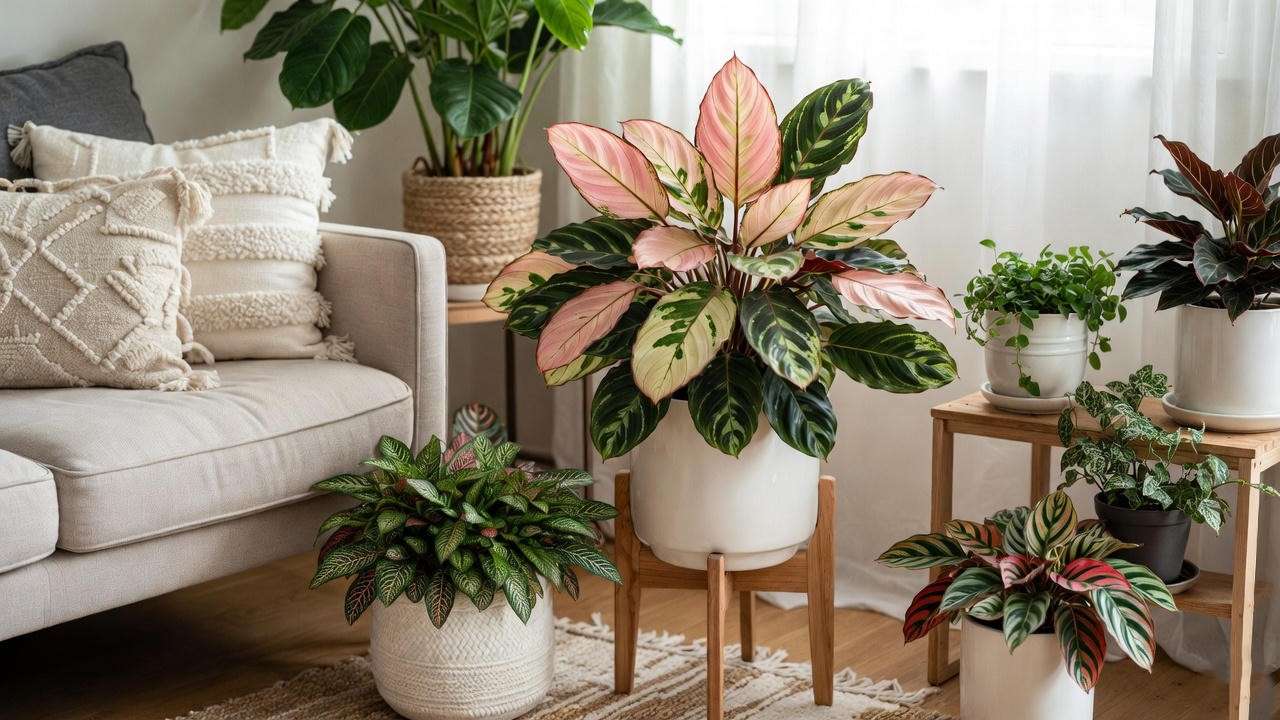
Creating Focal Points and Plant Groupings
Coloured indoor plants shine as focal points or in curated groupings. Place a large Stromanthe Triostar in a corner to draw the eye, or cluster smaller plants like Fittonia and Peperomia Rosso on a shelf for a lush, layered look. Vary heights with plant stands or stack books under pots to add dimension. Styling Idea: Group a Pink Syngonium, Tradescantia Nanouk, and Calathea Rattlesnake on a mid-century plant stand for a vibrant, cohesive display that screams modern elegance.
Incorporating Plants into Different Rooms
Each room in your home can benefit from the charm of coloured indoor plants:
- Living Room: A bold Aglaonema ‘Siam Aurora’ in a sleek pot serves as a statement piece near a sofa or coffee table.
- Bedroom: Opt for a calming Fittonia on a nightstand to promote relaxation, as its vibrant veins add subtle colour without overwhelming the space.
- Bathroom: Humidity-loving Calathea Rattlesnake thrives in steamy conditions, making it ideal for a bathroom shelf or windowsill. Tip: Use wall-mounted planters or hanging baskets in small spaces to maximize floor area while showcasing cascading plants like Tradescantia Nanouk.
5. Mistakes to Avoid with Coloured Indoor Plants 🚫
Overwatering and Poor Drainage
Overwatering is the leading cause of plant stress, especially for coloured indoor plants with sensitive roots. Soggy soil can lead to root rot, causing leaves to yellow or drop. For example, Aglaonema thrives with infrequent watering, while Fittonia needs consistent moisture but not waterlogging. Solution: Always use pots with drainage holes and a saucer to catch excess water. Check soil moisture with your finger or a moisture meter before watering.

Incorrect Lighting
Lighting mistakes can dull the vibrant hues of coloured plants. Too little light causes variegation to fade, as seen in Coleus or Pink Syngonium, while direct sunlight can scorch delicate leaves like those of Stromanthe Triostar. Solution: Place plants in bright, indirect light, such as near a north- or east-facing window. If direct sun is unavoidable, use sheer curtains to filter it. Expert Tip: “Rotate plants every two weeks to ensure even light exposure,” says horticulturist Dr. Emma Green.
Neglecting Humidity
Many coloured indoor plants, like Calathea and Stromanthe, are tropical natives that crave high humidity (50–60%). Low humidity can cause leaf curling or browning, especially in winter. Solution: Invest in a humidifier or create a DIY pebble tray—fill a shallow tray with pebbles and water, then place the pot on top, ensuring the base doesn’t touch the water. Mist plants like Fittonia weekly to boost humidity. DIY Recipe: Pebble tray = 1 tray + 1 inch of pebbles + water just below pebble level.
6. Sustainability and Sourcing Coloured Indoor Plants 🌍
Where to Buy Coloured Indoor Plants
Finding high-quality coloured indoor plants is easier than ever. Reputable online nurseries like The Sill, Bloomscape, or Etsy sellers offer a wide range of vibrant varieties, often with care instructions. Local garden centers or plant shops are great for inspecting plants in person. Tip: Look for certifications like organic or sustainably grown to ensure eco-friendly practices. Always check reviews for online sellers to avoid subpar plants or shipping issues.
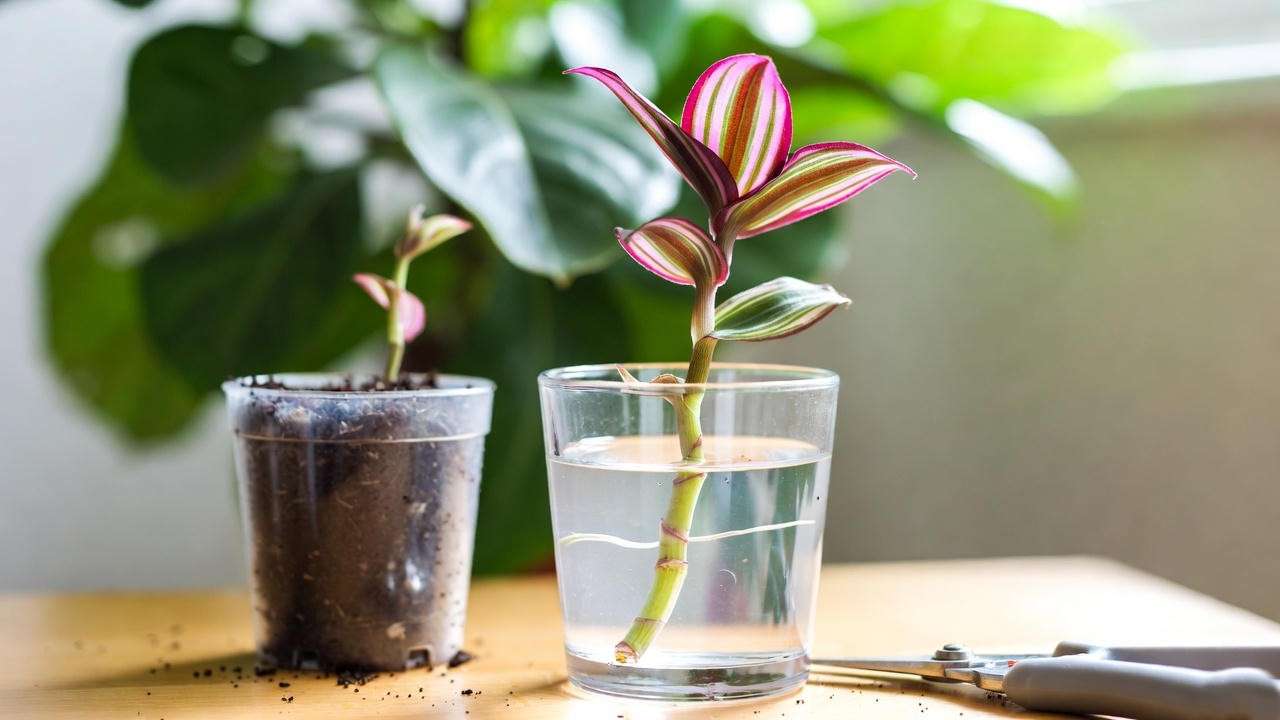
Propagating Your Own Plants
Propagation is a sustainable, cost-effective way to grow your collection or share plants with friends. Most coloured indoor plants, like Tradescantia Nanouk or Pink Syngonium, propagate easily from stem cuttings. Step-by-Step Propagation:
- Cut a 4–6-inch stem with at least one node (where leaves attach).
- Remove lower leaves, leaving 2–3 at the top.
- Place the cutting in water or moist soil, keeping it in bright, indirect light.
- Roots should form in 2–4 weeks; transplant to soil once roots are 1–2 inches long. Benefit: Propagation reduces the need to buy new plants, lowering your environmental footprint.
Eco-Friendly Care Practices
Sustainable plant care starts with mindful choices. Use natural fertilizers like compost tea or worm castings instead of synthetic options. Opt for reusable terracotta or ceramic pots over single-use plastic ones. Recycle water from dehumidifiers or fish tanks to irrigate plants, reducing waste. Expert Insight: “Sustainable care preserves both your plants and the planet,” says environmental horticulturist Dr. Maria Lopez. Choose peat-free potting mixes to avoid depleting natural wetlands.
7. FAQs About Coloured Indoor Plants ❓
Your Questions Answered
- Why do my coloured plants lose their vibrancy? Fading colours often result from insufficient light or nutrient deficiencies. Move the plant to a brighter spot and fertilize monthly during the growing season with a balanced 10-10-10 fertilizer.
- Are coloured indoor plants safe for pets? Some, like Calathea Rattlesnake and Fittonia, are pet-safe, while others, like Pink Syngonium and Aglaonema, are toxic if ingested. Check the ASPCA’s plant toxicity list before buying.
- How often should I fertilize my coloured plants? Fertilize monthly in spring and summer, pausing in fall and winter when growth slows. Use a diluted liquid fertilizer to avoid root burn.
- Can I grow coloured plants in low-light homes? Yes, choose low-light-tolerant varieties like Aglaonema or Peperomia Rosso. Supplement with a grow light if needed.
| Plant | Pet-Safe? | Toxicity Notes |
| Calathea Rattlesnake | Yes | Safe for cats and dogs |
| Fittonia | Yes | Non-toxic, ideal for pet homes |
| Pink Syngonium | No | Toxic if ingested; keep away from pets |
| Aglaonema | No | Toxic to pets and humans if ingested |
Conclusion: Create Your Vibrant Indoor Oasis 🌟
Coloured indoor plants are more than just greenery—they’re a vibrant way to express your style, boost your mood, and transform your home. From the beginner-friendly Fittonia to the striking Stromanthe Triostar, these plants offer endless possibilities for creating a stunning indoor jungle. By following our expert care tips—proper lighting, mindful watering, and humidity management—you’ll keep your plants thriving and colourful year-round. Start small with a Peperomia Rosso or go bold with a Purple Passion Plant, and watch your space come alive. Share your plant journey in the comments or tag us on Instagram—we’d love to see your vibrant oasis! 🌿
Call to Action: Ready to add a splash of colour to your home? Pick one of these stunning plants and explore our related articles, like “Best Low-Light Indoor Plants” or “How to Create a Plant Care Routine,” for more inspiration.

